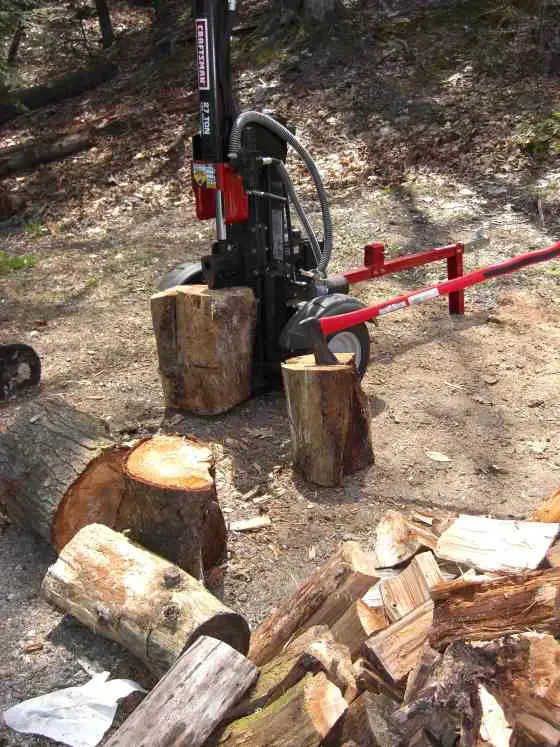Firewood Splitter Choices

DEAR TIM: Now that the snow has gone, it’s time to cut, split and store firewood for next winter here in the Northeast. Can you tell me what type of firewood splitter you would use if you had to split many cords of firewood? When I was younger, I swung a splitting maul, but now my shoulders are not able to do it for long. I’m also interested in any advice you might have about the storage of firewood. Do you use outdoor firewood racks for your fireplace firewood? Jerry F., North Conway, NH
DEAR JERRY: Hello neighbor! I’m a new resident of New Hampshire and quickly adjusted to the ritual of firewood preparation each spring. Heating a home with firewood is commonplace here, and it can take many cords of split dried wood to heat a home for six months.
I’ve noticed that as I get older my joints aren’t as reliable as they used to be. A very good friend of mine just had to have the rotator cuffs in both of his shoulders repaired. He worked construction like me and the heavy work indeed takes its toll on the body. I have a lesser, though not insignificant, occupational injury to my left thumb that limits my gripping power, so I always look for a mechanical advantage when working.
I have taped videos about firewood splitters that play on YouTube. I show three different types starting with a standard maul. I constantly get comments from young bucks who say a maul is faster and better than any mechanical machine. They may not say that if they saw the power of a commercial log splitter that can actually split long lengths of firewood all at once.
Furthermore, a machine goes for hours and hours at the same speed without a need for rest. You can’t say that about someone swinging a maul. At some point they get tired, very tired.
Regular homeowners can’t justify the cost of those amazing commercial machines, so they have to pick between the other two firewood splitters I show in my video. The two machines both use hydraulics to split the wood, however one is human powered and the other one is powered by a gasoline engine.
The hand-pump splitter is a cute little machine that uses a standard hydraulic car or truck jack to split wood. The jack is mounted horizontally on an I-beam. You can load up to an 18-inch log into the splitter and then start cranking the jack handle back and forth. I’ve split massive oak logs that are up to 24 inches in diameter using this tool. This machine is not fast, but it absolutely can split wood, even log links that have knots in them.
The real powerhouse is the hydraulic log splitter that has a ram similar to those you might see on a backhoe, bulldozer or other piece of heavy equipment. A gasoline engine powers a hydraulic pump that pressurizes hydraulic oil in the ram.
The machine I have can exert 54,000 pounds of pressure on a log. That kind of force will split the most knotty and toughest wood you can find. All you have to do is press lightly on a simple handle that controls the back and forth motion of the hydraulic ram.
These wonderful machines come mounted on small trailers you can tow behind a truck or a car. The most versatile ones allow the hydraulic ram to rotate 90 degrees to the vertical position so you don’t have to lift log links. All you do is stand them up on the ground under the ram and watch the ram slowly push apart the wood as if it's on a Sunday picnic.
I don’t use firewood storage racks, although I can see how handy they are. I do place my firewood up off the ground on 4x4 pieces of lumber so the wood stays dry. At the ends of my stacks, I stack each layer of split pieces of firewood at 90-degree angles to one another. This tower usually produces enough resistance so the firewood doesn’t tumble to the ground at each end of the pile.
I’ve seen all sorts of firewood holders, some of which use discarded wood pallets. The pallets are stood up at the end of the firewood piles acting like elevated retaining walls. Diagonal bracing extends from the pallets to the ground locking them into position. This is a crude method, but it absolutely works if you can’t afford a metal firewood log rack.
It can take months for firewood to dry, so it’s a great idea to cut and split firewood in the early spring. I tested just cutting the logs to firewood length and stacked them to dry for over a year. When I split them, they were still filled with an enormous amount of moisture, even though the links were open to plenty of air and sun. I even had the top of the wood covered to prevent rain from getting on the links. It’s vital to cut and split the wood at the same time.
Be sure to know the correct length to cut your wood. I’ve known people who cut two or three cords of wood only to discover it was 2 inches to long to fit into a fancy wood stove. If you’re cutting up logs, use a long stick that has painted lines representing the correct length for your needs. Set the stick next to the log you’re cutting and simply make a quick starter cut with your chain saw on top of the log that lines up with the painted lines.
Column 828